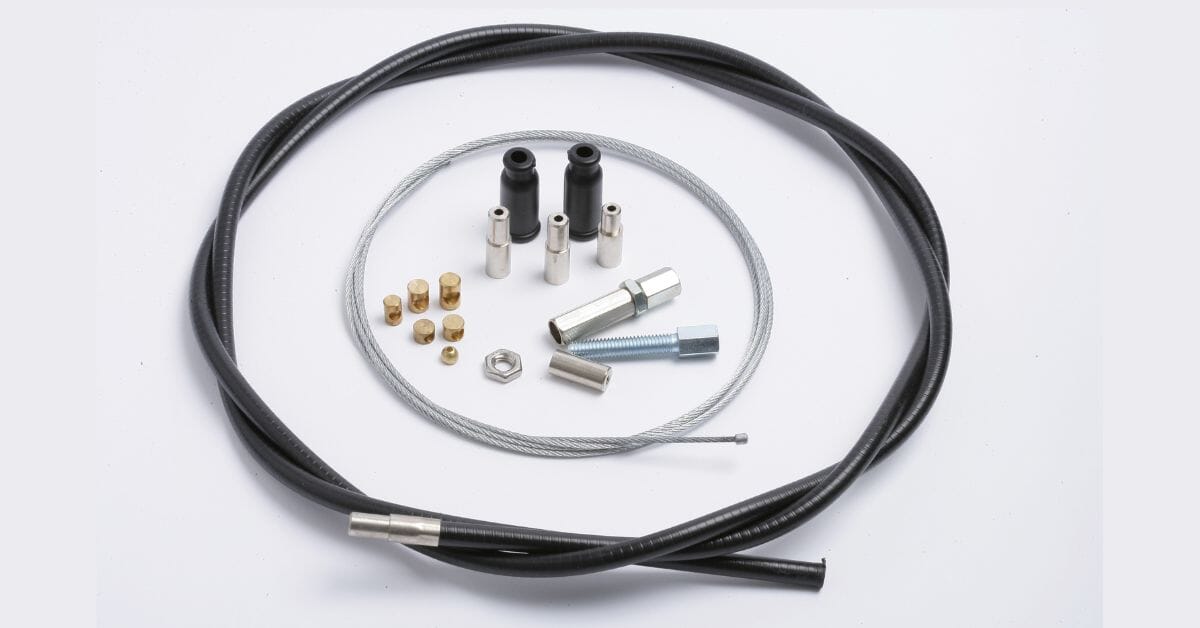Useful Motorcycle Fittings and Components Every Cable Builder Should Have

Motorbike Cable Fittings and Components
Although seemingly simple at first glance, control cables are intricate components. The task of translating the rider’s inputs into specific mechanical actions - like opening and closing a throttle or operating a brake - isn’t simple and takes a series of complex and very specific parts. Let's take a closer look at the main components, their roles, and why quality is crucial for each and every one.
Inner Wire: The Power Transmitter
What It Is: The inner wire is the primary working element of a cable system, typically constructed from strands of steel or stainless steel braided for strength and flexibility.
What It Does: The inner wire directly transfers the force applied by the rider to the motorcycle’s mechanism, such as pulling the clutch lever or twisting the throttle. Its tension and movement are critical for precise control.
Why It Matters: Durability and smooth operation are key. A frayed or weak inner wire can snap under pressure, leading to sudden loss of control. Premium cables, like those from Venhill, use stainless steel for superior strength and corrosion resistance.
Conduit (Cable Housing): The Protector and Guide
What It Is: The outer cable, also known as the conduit, is a rigid or semi-rigid tube that encloses the inner wire. It’s typically reinforced with a spiral-wound steel core and covered in a weather-resistant sheath like PVC or nylon.
What It Does: The conduit provides a stable pathway for the inner wire, preventing it from flexing or snagging under tension. It also shields the wire from external elements such as moisture, dirt, and debris, which can cause wear.
- Reinforcement Layer: Adds strength to resist compression when the cable is bent.
- Sheathing: Protects against environmental damage and reduces friction with the surrounding motorcycle parts.
Why It Matters: A robust outer cable ensures smooth operation and prevents premature wear. Poor-quality housing can split and damage, exposing the inner workings.
Liner: The Friction Reducer
What It Is: The liner is a low-friction tube located inside the outer cable, allowing the inner wire to glide freely. Common materials include nylon and PTFE (‘teflon’).
What It Does: By minimising friction, the liner ensures efficient transmission of force and a smooth feel at the controls. It also reduces wear on the inner wire, prolonging the cable’s lifespan.
Why It Matters: High-performance liners are essential for precision and responsiveness. Without a liner, friction between the inner wire and housing could result in sluggish controls, increased effort, and accelerated wear.
End Fittings (Nipples): The Connectors
What They Are: End fittings, often called nipples, are fixed to the ends of the inner wire and are custom-shaped to fit specific levers or mechanisms. Common types include barrel, pear, and slotted nipples.
What They Do: End fittings anchor the inner wire to its control point, allowing for reliable transmission of force. Their precise shape ensures a snug fit, preventing unwanted movement or slippage.
- Barrel Nipples: Common on throttle and clutch cables.
- Pear Nipples: Often used on drum brake systems.
Why It Matters: A poorly fitted nipple can slip or detach, leading to loss of function. High-quality fittings are machined or cast with precision to ensure durability and secure connections.
Ferrules: The Outer Cable Anchors
What They Are: Ferrules are small metal or plastic collars crimped or slipped onto the ends of the outer cable.
What They Do: Ferrules provide a stable interface between the outer cable and the component it connects to, such as an adjuster or lever housing. They also help maintain the integrity of the cable housing by preventing fraying or deformation under pressure.
Why It Matters: Without ferrules, the outer cable could deform or wear prematurely, causing inconsistent tension in the inner wire. Durable, well-fitted ferrules ensure longevity and reliable performance.
Adjusters: The Tension Tuners
What They Are: Adjusters are threaded components that allow for precise calibration of cable tension. Commonly located at the lever perch or inline along the cable, they’re typically made of brass, steel, or aluminum.
What They Do: Adjusters fine-tune the slack in the cable to ensure optimal performance:
- Throttle Cable: Minimal slack ensures responsive acceleration.
- Clutch Cable: Proper tension prevents clutch drag or slipping.
- Brake Cable: Maintains effective braking force.
Why It Matters: A well-adjusted cable improves control and safety. Overly slack cables result in delayed response, while overly tight cables can cause binding or unnecessary wear.
Sleeves and Seals: The Environmental Guards
What They Are: Rubber or plastic seals and sleeves located at the entry and exit points of the cable system.
What They Do: They block contaminants like water, dust, and grit from entering the cable housing. Seals also reduce wear on the inner wire by preventing abrasive particles from reaching it.
Why It Matters: Without effective seals, cables can degrade rapidly in harsh environments, leading to stiff or failing controls. Quality seals are a must for off-road or all-weather riders.
Cable Ties and Clamps: The Organisers
What They Are: Simple but essential components used to secure cables along the motorcycle frame.
What They Do: They prevent excessive movement and keep cables routed neatly, reducing the risk of damage from abrasion, heat, or snagging.
Why It Matters: Properly secured cables not only look tidier but also perform better, as excessive movement can lead to wear and misalignment.
The Importance of High-Quality Cables
Using well-engineered cables ensures reliable and precise control, reducing the likelihood of mechanical failures. Venhill’s cables are designed with advanced materials, precision fittings, and superior attention to detail, offering:
- Durability: Resistant to corrosion, wear, and fraying.
- Performance: Low-friction liners and precision fittings for smooth operation.
- Safety: Secure connections and reliable components that perform under pressure.
When it comes to motorcycle cables, the details matter. For high-performance cables that you can trust, browse Venhill’s range.


